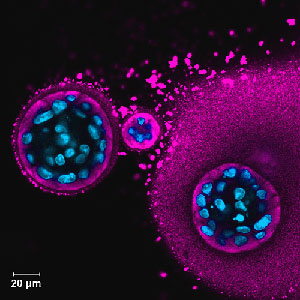Developing Salivary Components as Therapeutics for Oral Health
Background
Saliva plays an essential role in oral health, supporting an environment for the oral microbiota, enhancing wound healing, and providing a source of the minerals that harden tooth enamel. Salivary glands damaged by medication, illness, autoimmune disorders, or cancer radiation therapy produce less saliva. The resulting saliva loss causes dry mouth that can lead to oral health issues such as increased risk of cavities, bad breath, burning sensation in the mouth, changes in taste, and fungal infections. The saliva substitutes developed thus far have limited abilities to replace the many functions of saliva and only offer short-term relief.
NIDCR’s Response
In response, NIDCR issued the Developing Salivary Components as Therapeutics for Oral Health notices of funding opportunities, or NOFOs (R01, R21). The NOFOs invited applications focused on developing therapies or solutions that replicate the many functions of saliva, restoring oral health. Considering recent NIDCR-supported discoveries that identified the genes and protein components of saliva 1,2, this initiative solicited plans for developing therapies that can induce these missing components or provide functional substitutions that promote a healthy oral microbiota, boost healing, or remineralize tooth enamel.
NIDCR-Funded Awards
In 2024, NIDCR granted four awards totaling approximately $1.7 million per year for up to five years of support.
| Award Number | Principal Investigator(s) | Institution | Award Title |
|---|---|---|---|
| R01-DE034121 | Yuyu Sun Chih-Ko Yeh | University of Massachusetts Lowell | Salivary Peptide/Protein-Based Multilayer Denture Coatings for Controlling Candida Biofilm Formation and Denture Stomatitis |
| R01-DE034141 | Mira Edgerton | State University of New York at Buffalo | Salivary Zinc Modifies Histatin 5 Activity Towards C. albicans Survivor Cells and Commensalism |
| R21-DE034146 | Feng Li | University of California Los Angeles | The Function Role of Salivary piRNAs in Oral Wound Healing |
| R56-DE034153 | Kamil Godula Stefan Hans-Klaus Ruhl | University of California, San Diego | Engineering Mucin Analogues to Benefit the Mouth Environment |
1Saitou M, Gaylord EA, Xu E, May AJ, Neznanova L, et al. Functional Specialization of Human Salivary Glands and Origins of Proteins Intrinsic to Human Saliva. Cell Rep. 2020 Nov 17;33(7):108402.
2 Huang N, Pérez P, Kato T, Mikami Y, Okuda K, et al. SARS-CoV-2 infection of the oral cavity and saliva. Nat Med. 2021 May;27(5):892-903.
October 2024

